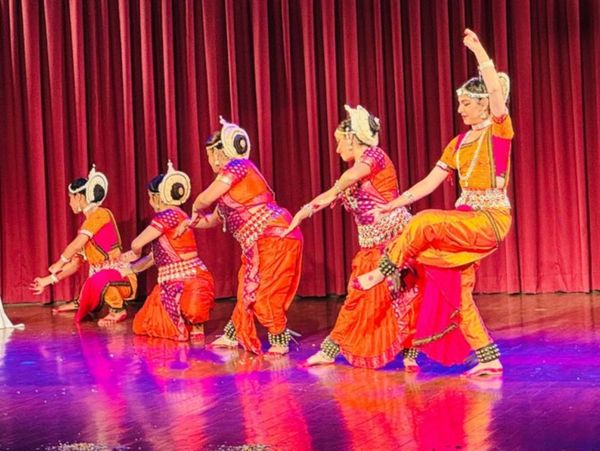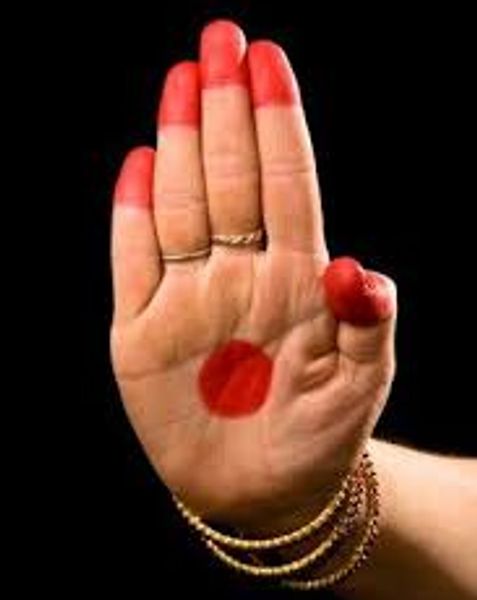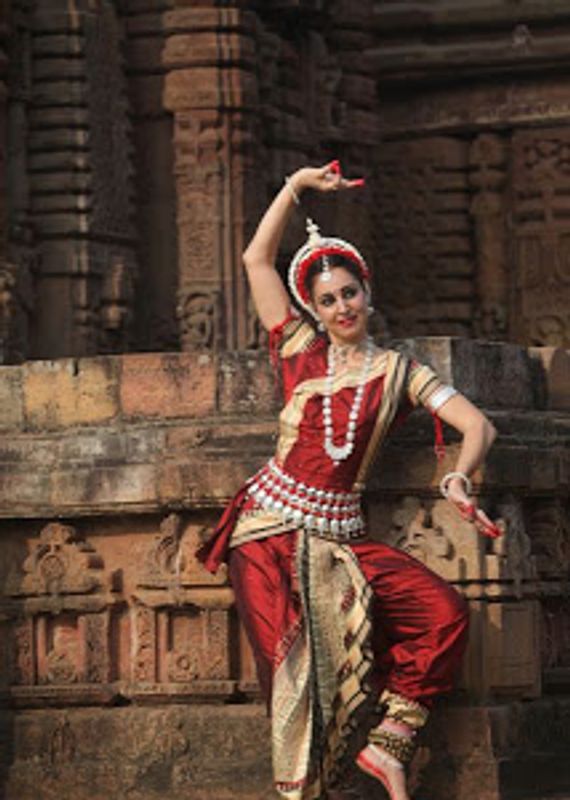Our Goal

Go Odissi is a web page dedicated to the Odissi dance form. Every classical dancer wants recognition for their art form, whether in the form of more commerciality or better facilities for practice. As a classically trained Odissi dancer, I’ve always wanted more recognition for this art form. That’s how the concept of Go Odissi came up. Whenever someone finds out that I’m an Odissi dancer their first question is “Where do you learn to dance?” or “Are there any institutions for learning Odissi?” The fact that people lack the resources and knowledge of this art form is truly saddening. Through Go Odissi, we wish to answer everyone’s unanswered questions about this truly unique art form. Go Odissi is a one-stop destination for any aspiring Odissi dancer
Take Your Pick
Single Hand Gestures
Single Hand Gestures
Conjunctive hand gestures
Conjunctive hand gestures
Conjunctive hand gestures
Conjunctive hand gestures
Foot positions
Conjunctive hand gestures
Traditional Dance wear
Traditional Dance wear
Conjunctive hand gestures
Traditional Dance wear
Origins Of Odissi
The earliest mentions of Odissi are found in the natya shastra written by Bharat Muni in the 2nd century. Odissi dance is closely linked to the temples of Odissa, where it was performed as a part of religious ceremonies as well as for entertainment. Odissi dance is often performed as a testimony of one's dedication to Lord Jagarnath, Shri Krishna and other deities.
An empirical part of understanding Odissi's dance is learning about the 'Maharis'. Maharis were female temple dancers, Maharis spent the course of their lives dedicated to deities serving them through dance. With the onset of the colonial rule Odissi dance was at a decline, Maharis played an influential role in the revival of Odissi dance in the 20th century.Today the the Mahari tradition is no longer in practice, however their contributions to this dance form have shaped odissi dance in the modern day.
Gotipuas played an essential role in the continuity of Odissi dance. Gotipuas were young boys (Goti- SIngle Pua-boy) who dressed up as young women, adorned in costume sarees, jewellery and elaborate eye makeup, their appearance closely resembles the modern-day originial costume. . Gotipuas showed their devotion to Lord Jagarnath through Odissi dance, continuing a dance form originally done by the Maharis.
The origins of Odissi dance are deeply rooted in the temples of Odissa. From the carvings of the dancers at the Konark Sun temple to the famous Yath Ratra and Bhubaneshwar, this dance form depicts the diversity of India. It is important to know one's history, to know our history is to know one's self hence learning about the Origins of Odissi is important for every aspiring Odissi Dancer.
Hand gestures or हस्ता मुदरा

What are Hand gestures or हस्ता मुदरा?
In any Indian classical dance form there are certain hand gestures that are used to describe the story line of the dance. In Odissi dance we have two types of Hand gestures or हस्ता मुदरा, single hand gestures, or ासंयुक्ता हस्ता; Conjunctive hand gestures or संयुक्ता हस्ता
Let us further discuss each of these in detail.
Single hand gestures or ासंयुक्ता हस्ता
1.Pataka (Flag) – All fingers extended and held close together, palm facing outward, thumb pressed against fingers.
2.Tripataka (Three parts of a flag) – Same as Pataka, but ring finger bent.
3.Ardhapataka (Half flag)– Same as Pataka, but little finger and ring finger bent.
4.Kartarimukha (Scissors)– Index and middle finger stretched apart like a “V,” others closed with thumb.
5.Mayura (Peacock) – Thumb and ring finger touch, other fingers extended gracefully.
6.Ardhachandra (Half moon) – All fingers extended, thumb stretched outward (like a hand “stop” sign with thumb open).
7.Arala (Bent) – Index finger bent, other fingers upright, thumb touching bent finger.
8.Shukatunda (Parrot’s beak) – Index finger bent slightly forward, thumb bent and touching it, other fingers closed.
9.Mushti (Fist)– All fingers folded into a fist, thumb placed over them.
10.Shikhara (Peak)– Fist with thumb extended upward.
11.Kapitta – Fist with index finger curled around thumb (like holding flowers or cymbals).
12.Katakamukha (Opening a bracelet) – Three variations: usually thumb and index + middle fingers joined, other fingers stretched.
13.Suchi (Needle/Pointing)– Index finger extended straight, other fingers closed with thumb.
14.Chandrakala (Crescent moon) – Shikhara hasta but index finger also extended (like a hook).
15. Padmakosha (Lotus bud) – Fingers loosely bent and spread, cupped together like holding water.
16. Sarpashirsha (Snake’s head) – Fingers stretched together, palm bent slightly forward (like a hood of a snake).
17. Mriga Shirsha (Deer’s head) – Thumb, middle and ring fingers joined; index and little fingers extended.
18. Simhamukha (Lion’s face) – Thumb, middle and little fingers extended; index and ring fingers bent toward palm.
19.Kangula (Little bell)– Ring finger bent, other fingers extended.
20.Alapadma (Fully bloomed lotus) – All fingers spread wide and curved outward (like a blossoming flower).
21.Chatura (Cleverness) – Thumb, index and middle fingers together, ring and little fingers bent slightly.
22. Bhramara (Bee)– Thumb and middle finger touch, index finger slightly bent, ring and little fingers extended.
23. Hamsasya (Swan’s beak) – Thumb and index finger touch at tips, other three fingers extended.
24.Hamsapaksha (Swan’s wing)– All fingers stretched together, with little finger bent.
25. Sandamsha (Pincers) – Fingers open and close repeatedly, fingertips touching like pincers.
26.Mukula (Bud) – All fingers and thumb joined together at tips, palm facing upward.
27.Tamrachuda (Rooster’s crest) – Ring finger touches thumb, index and middle fingers extended, little finger stretched outward.
28.Trishula (Trident) – Index, middle, and ring fingers extended straight up; thumb and little finger folded.
Conjunctive hand gestures or संयुक्ता हस्ता
1. Anjali – Hands joined together in salutation.
2. Kapota – Hands joined, leaving slight space between the palms, used to show respect or submission.
3. Karkata – Fingers interlocked, used to depict gathering or stretching.
4. Swastika – Two hands crossed at the wrists, used to denote union or stability.
5. Dola – Hands down by the sides, often used in starting or ending postures.
6. Pushpaputa – Hands cupped together like holding flowers, used for offering or receiving.
7. Utsanga – One hand placed on the opposite shoulder, used to show embrace or affection.
8. Shivalinga – Left hand in Ardhachandra, right hand in Shikhara placed on it, representing Lord Shiva.
9. Katakavardhana – Hands in Kataka-mukha joined together, used to show marriage or friendship.
10. Kartariswastika – Hands crossed with fingers in Kartari-mukha, used to show trees, branches, or separation.
11. Shankha – Hands joined to form the shape of a conch, used to represent the sacred conch.
12. Chakra – Hands joined to form a circular shape, representing the discus or wheel.
13. Samputa – Hands cupped together as if holding or concealing something.
14. Pasha – Hands crossed to show a noose or bond.
15. Kilaka – Hands interlocked with fingers, used to show affection or friendship.
16. Matsya – Hands joined to form the shape of a fish.
17. Kurma – Hands shaped to represent a tortoise.
18. Varaha – Hands shaped to represent a boar.
19. Garuda – Hands positioned to form the shape of a bird, symbolizing Garuda.
20. Nagabandha – Hands intertwined to represent coiled serpents.
21. Khatva – Hands forming the shape of a bed or cot.
22. Bherunda – Hands joined to depict a pair of birds or a fierce form.
Foot positions or पद भेद
1. Sama Pada – Both feet together, body erect and straight.
2. Tribhanga – The body bent in three places: neck, torso, and knee.
3. Chauka – A square-like posture symbolizing Lord Jagannath, with knees and elbows bent.
4. Eka Pada– Standing on one leg, the other leg bent or lifted.
5. Kunchita Pada – Toes bent, heel slightly raised.
6. Agratala Sanchari – Movement of the feet with toes striking the ground.
7. Udvartita Pada – Heel raised, toes touching the ground alternately.
8.Anchita Pada– Heel on the ground and toes raised upward.
9.Kshipta Pada– One leg extended forward or to the side.
10.Suchi Pada– Standing on toes, body balanced like a needle point.
11.Rechita Pada– Stretching or swinging movement of one leg.
12.Prerita Pada– Pushing or propelling movement of one foot by the other.
13.Udghatita Pada– Opening or lifting of the foot from the floor.
14. Anchita Rechita Pada– Combination of lifting and stretching of the leg.
15.Samapada– Both feet close together in rest position.
16.Ayata Pada– Feet apart, knees slightly bent.
17.Swastika Pada– Feet crossed one over the other.
18.Aalapadma Pada– Feet turned outward like an open lotus.
19. Nupur Pada– Small rhythmic stamping of the feet to accent the beat.
20.Parshva Sanchari– Sideward shifting or gliding movement of the feet.
Learn about the traditional Odissi dance Coustume

Patta Saree
The main garment in the Odissi dance is the silk patta saree, which is about 9 yards long. These sarees are of bright colours and adorned with shiny embellishments to appeal to the eye of the audience. The saree is draped carefully to allow the dancers to carry out their flexible movement.

Blouse
The blouse also known as the kanchaula, is a tight fitting garment providing structure to the dancers body. It sometimes resembles the colours of the saree whereas sometimes it provides a startling contrast.

Jewellery
Odissi dancers wear silver jewellery which acts as a show-stopping element, catching the audience's eye. The Jewellery includes-
1. The Matha Patti- The matha patti is pinned at the back of the dancer's scalp, and the tikka traditionally the size of a coin falls on the dancer's forehead. Whereas the rest of the patti extends from the partition of the head along the hairline of the dancers.
2.The Haar -neckpiece traditionally known as haar includes a long necklace and chocker.
3. The Kamarbandh-The Kamarband or waste is an ornament worn around the waist it consists of thick silver pieces in different shapes with are tied together by a red thread. The Kamar bandh consists of three to four layers of silver metal with red thread. The Kamar bandh goes around the waist of the dancer and helps to emphasize the movement of the torso.
4. Armlets (Bahichudi or Bajuband): Worn on the upper arms.
5. Bangles (Kankana): Wide filigree bracelets adorning the wrists

Head Gear
The most distinct eye catching element of Odissi dance is its elaborate head gear. This includes a Tahiya which is a circuar ornament adorned with white flowers which goes around the dancers bun.

Make up
To capture the essence of the dance, dancers wear heavy makeup highlighting their features. This helps them to appeal to the audience's emotions.
Start Your Dance Journey Now-
Choose your city-
New Delhi
1. Triveni Kala Sangam
Offers regular and certificate courses in Odissi dance. Classes are held on Mondays and Fridays from 5:00 PM to 7:00 PM, and on Saturdays from 11:00 AM to 1:00 PM.
2. Debadhara Odissi Dance Academy
Founded by Guru Binayak Panda in 2003, this organisation promotes the Debaprasad Das gharana of Odissi.
3. Odissi Natya Sala
Established in 1999 by Anita Babu, an alumna of Orissa Dance Academy, Bhubaneswar.
4.Aaradhana Kala Kendra
Located near DAV School, Jungpura Extension, offering Odissi dance classes.
5.Utsav-Educational and Cultural Society
Founded by Padmashree and SNA awardee Ranjana Gaur Ji.
Bhubaneswar
1. Srjan (Guru Kelucharan Mohapatra Odissi Nrityabasa)
Founded in 1993, Srjan offers regular dance classes and special sessions for international students.
2. Orissa Dance Academy
A premier cultural institution under the guidance of Guru Aruna Mohanty.
3.Lasyakala Dance Vision
A premium institution working to develop Indian classical dance in rural and tribal areas.
Kolkata
1. Nrityam Odissi Dance Centre
Offers certification courses in Odissi dance.
2. Kolkata Mayur Lalit Dance Academy
Led by Debamitra Sengupta, offering Odissi dance training.
Mumbai
1.Kaishiki Nrityabhasha: Founded by Guru Daksha Mashruwala, this institute offers Odissi dance training.
2. Sanskrita Foundation: Provides traditional dance training in Odissi, Bharatanatyam, Kathak, and other forms.
Bangalore
1. Odissi Dance Centre (ODC)
Founded by Devjani Sen, offers individual attention to students of all levels and ages.
2.Nrityantar Academy of Performing Arts : Provides Odissi dance training with branches across the city.
3. Nrityagram Dance Village: Offers non-residential training through city classes and a Sunday class for young students.
Gurgaon
1. Nritya Dhara
Founded by Vani Madhav, offering Odissi dance classes blending tradition with innovation.
This website uses cookies.
We use cookies to analyze website traffic and optimize your website experience. By accepting our use of cookies, your data will be aggregated with all other user data.